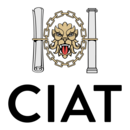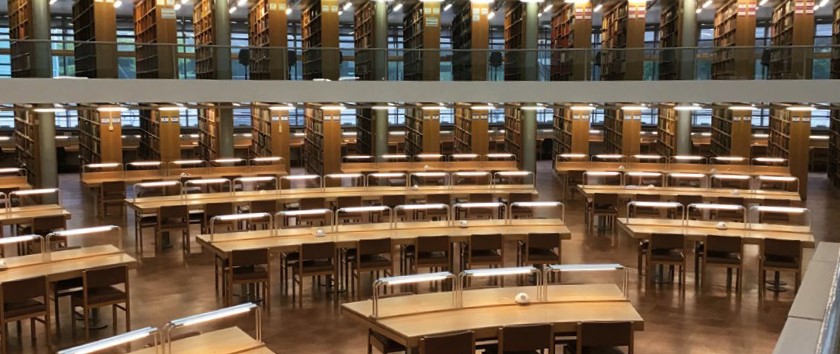Seeley Library
Photo courtesy of CIAT.
Contents |
[edit] Introduction
The architectural practice of rhp has been involved with the remarkable Faculty of History building for over a decade. The company's most recent project has the been the refurbishment of the Seeley Library.
[edit] History
The Seeley Library is Grade II* listed and lies within the West Cambridge conservation area. The Library was commissioned through an invited architectural competition during March 1963 and for which the design by James Stirling (and his then partner James Gowan) was considered to respond perfectly to the brief.
Construction of the Seeley Library commenced in October 1964 and the building was occupied towards the end of 1968. It was listed in April 2000 and is the second of three university commissions by James Stirling distinguished by their ‘functional expressionism’ and use of red brick and glass. The Leicester University Engineering Building (1961-3, Grade II), was the first and the Florey Building, Queen’s College, Oxford (1966-71, Grade II) the third.
“They are amongst the most important and recognisable British buildings of the 1960s and have been the inspiration for designers and their buildings world-wide.” Statement of Heritage Significance – The History Faculty, University of Cambridge, Beacon Planning, June 2017.
[edit] The setting
The Seeley Library stands in the grounds of a former large 19th century domestic property, ‘Traverston’, fronting onto West Road, which was one of three properties purchased by the University in 1961. The original site spanned the gardens of two properties and when one of the tenants refused to give up part of their garden, the competition design was rotated anti-clockwise to fit within the boundary of the one property. As a consequence, the glazed roof of the Library faces south, into the site, and the elevation with the twin towers, originally intended to face east towards the main circulation route, faces north.
Stirling and Gowan was dissolved in December 1963, and the library commission was transferred to James Stirling’s new practice. The project was constrained by a budget and timescale imposed by the University Grants Committee.
The competition drawings were submitted in a planning application on 26 June 1963 and approval was granted on 23 July 1963. The project was tendered in July 1964 and construction commenced in October 1964.
[edit] Preservation aspects
An Historic Structures Report was commissioned from John McAslan & Partners in 2000, following the building’s inclusion on the List of Buildings of Historic Interest. This report stands alongside a masterplan for conservation and adaptation which has informed subsequent projects of repair and maintenance. The building was originally Grade II listed in 2000 but its status was raised to Grade II* in March 2018. This change did not vary rhp’s approach, as the company had already considered the significant heritage of the building when planning the project.
The refurbishment works were designed to improve the aesthetic and functional aspects of the library whilst respecting its status and world-wide reputation.
As the library is a popular and well used facility, it was crucial the works did not disturb the students. To achieve this, they were carried out in a phased manner which allowed for extensive research into samples and their suitability to be carried out.
The students were also involved in the selection of materials, for example, desk lights were trialled using both warm and cool lamps which meant these could be tested throughout the year with the changing lighting conditions and enabled the library to make an informed choice. The cork floor refurbishment has been particularly successful in unifying the space and bringing it back into the original design aesthetic and, during darker hours, the impact of the improved desk lighting can be really seen.
[edit] Impact
Dr Linda Washington, Head of Humanities and Social Sciences Libraries & Seeley Librarian has said “the Library looks terrific and the refurbished desks, floor, new shelving and lights are a massive improvement. Library staff all really appreciate the time and attention to detail that has gone into this project, and I have particularly been impressed by the prompt and thorough communications keeping everyone up to date.”
Over the years, rhp has developed an excellent relationship with the Cambridge City Conservation Officer and the University’s Planning Officer which helped the Listed Building application run smoothly, and ensure the project was delivered on time and budget during a very constrained programme.
[edit] Project overview at-a-glance
Programme and construction value:
- Phase 1: six weeks, £50K
- Phase 2, 15 weeks, £460K
Overview of works:
- Providing 24-hour access to the library, basement, WCs and JCR social spaces with the introduction of new security doors to the ground and first floor.
- Improving disabled access with the installation of a new platform lift.
- New safety glazing to first floor mezzanine balcony balustrades.
- Additional and replacement book shelves.
- Refurbishing of the original beech reading desks and adding new desk lighting, USB and power outlets.
- Cleaning and general redecoration including refurbishment of the original cork library floor.
- Improving environmental conditions to Reference Room 6 by the introduction of a new secondary glazing system.
This article originally appeared in the Architectural Technology Journal (at) issue 132 published by CIAT in winter 2019. It was written by Toni Page MCIAT CIAT-Accredited Conservationist.
--CIAT
[edit] Related articles on Designing Buildings Wiki
IHBC NewsBlog
Old Sarum fire in listed (& disputed) WW1 Hangar - Wiltshire Council has sought legal advice after fire engulfed a listed First World War hangar that was embroiled in a lengthy planning dispute.
UK Antarctic Heritage Trust launches ‘Virtual Visit’ website area
The Trust calls on people to 'Immerse yourself in our heritage – Making Antarctica Accessible'
Southend Council pledge to force Kursaal owners to maintain building
The Council has pledged to use ‘every tool in the toolbox’ if urgent repairs are not carried out.
HE’s Research Magazine publishes a major study of the heritage of England’s suburbs
The article traces the long evolution of an internal programme to research 200 years of suburban growth
IHBC Context 183 Wellbeing and Heritage published
The issue explores issues at the intersection of heritage and wellbeing.
SAVE celebrates 50 years of campaigning 1975-2025
SAVE Britain’s Heritage has announced events across the country to celebrate bringing new life to remarkable buildings.
IHBC Annual School 2025 - Shrewsbury 12-14 June
Themed Heritage in Context – Value: Plan: Change, join in-person or online.
200th Anniversary Celebration of the Modern Railway Planned
The Stockton & Darlington Railway opened on September 27, 1825.
Competence Framework Launched for Sustainability in the Built Environment
The Construction Industry Council (CIC) and the Edge have jointly published the framework.
Historic England Launches Wellbeing Strategy for Heritage
Whether through visiting, volunteering, learning or creative practice, engaging with heritage can strengthen confidence, resilience, hope and social connections.
















Comments
As a Cam graduate and frequent occupant of Seeley, I take issue with several aspects of the story. First, the "brick" - at least on the upper exterior floors - was not real brick, but rather a sort of composite material façade. On more than one occasion, a section came loose and fell to the ground, almost braining a student.
Also, it's utility was always accepted begrudgingly. Many books were non-circulating, requiring their use only in the reading room. During late Michaelmas and Lent terms, when the wind picked up and the temperature fell, one could see their own breath while reading books, while the metal frames would contract, opening gaps around the panes of glass, through which the wind would whistle for hours at a high pitch. By Easter term, and throughout the summers, the sun beat down on the glass framed reading room, creating a greenhouse effect that was not only hot and humid within, but absolutely distrastrous for the books, both bindings and pages.